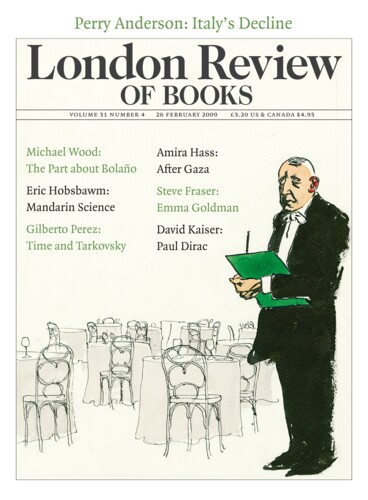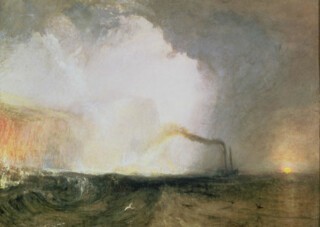In the first volume of his Coleridge biography, Richard Holmes describes Coleridge and Dorothy and William Wordsworth working ‘like plein-air painters, taking elaborate notes on the varied effects of light on the landscape, of plants and water, of wind and cloud and starlight’. They were under surveillance, suspected of Jacobin sympathies. A Home Office report provided
a classic description of Romantic poets at work, because it is recorded in absolute ignorance – or innocence – of the literary significance of what was being done … ‘man has Camp Stools, which he and his visitors take with them when they go about the country upon their nocturnal or diurnal excursions, and have also a Portfolio in which they enter their observations.’
It reads like a Max Beerbohm caricature. On the other hand, in the poems, letters and journals Holmes quotes there are things noticed which convince you that note-taking is an essential part of a poet’s job. Observation becomes vigorous engagement: ‘My Glass, being opposite to the Window, I seldom shave without cutting myself. Some Mountain or Peak is rising out of the Mist, or some slanting column of misty Sunlight is sailing cross me; so that I offer up soap & blood daily, as an Eye-servant of the Goddess Nature.’ In 1801, Coleridge took to fell-walking and climbing, pushing himself to exhaustion (fuelled on ‘brandy and – now – opium’, Holmes explains). On the summit of Carrock, ‘a thick cloud came on, and wrapped me in such Darkness that I could not see ten yards before me.’ He retreated from the rain and hail to a rocky shelter and there sat ‘with a total feeling worshipping the power & “eternal Link” of energy’. A little later the clouds parted and ‘a great blue panorama opened.’
In Coleridge’s description of the hailstorm, as in Turner’s account of having himself tied to the mast in order to watch a snowstorm at sea, the danger of being overwhelmed by the forces of nature is like a certificate of authenticity, of access to the true sublime. Whether Turner really saw the snowstorm in bondage isn’t quite the point. Nor should the fact that Coleridge might well have met a tourist on a Lake District mountaintop make one question the intensity of his embrace of the landscape. (A ‘lean expressive-faced man’ came upon him on Skiddaw, after Coleridge had scribbled ‘with a bit of slate my name among the other names’. The man exclaimed, after running over the names: ‘Coleridge! I lay my life, that is the Poet Coleridge.’ ‘Coleridge,’ Holmes writes, ‘for once remained silent.’)
The tourists, like a party jostling its guide, crowded in on the artists who formed their tastes. The observations that resulted in Turner’s Staffa, Fingal’s Cave were made on a trip to the cave by steamer, along with other searchers after the picturesque. There are comic possibilities in these meetings – Coleridge, in Holmes’s account, is aware that exalted seriousness can be absurd (thus the offering of ‘soap & blood’) – but the poetic painter and visually acute poet, in the early to mid-19th century, when colour postcards and photographic picture books hadn’t yet pre-empted the pleasures of a first encounter, could bring virgin sensibilities to be ravished by landscape and thrilled by wonders of weather (the spectre of the Brocken, for example, or sunrise from the Rigi, though Coleridge missed the former and Turner didn’t get round to making an ascent of the latter).
Their engagement was sustained by a breadth of interest and knowledge that isn’t common in a world where disciplines have divided. Coleridge, totting up his abilities, could reckon on ancient and modern languages, metaphysics, politics and even chemistry as well as poetry. He ordered botanical books and microscopes for himself and Wordsworth. Writing about nature went along with the intention, at least, of understanding it. Coleridge read Goethe’s scientific writings, Turner was much engaged with his theories of colour. But Turner was himself a reader and writer. When Ruskin devotes several pages in Modern Painters to The Goddess of Discord Choosing the Apple of Contention in the Garden of the Hesperides he first turns to the drama, the biblical parallels offered by troublesome gifts of apples, and its sources in Greek mythology. Turner’s own ‘Ode to Discord’ was not printed in the catalogue when the picture was first exhibited, but extracts from his Fallacies of Hope (‘that strange, inchoate and amorphous collection of scraps’, the Turner scholar Andrew Wilton calls it – he thinks that Turner could well have been dyslexic) were printed as epigraphs to his paintings in Academy exhibition catalogues. The received notion was that poetry and painting were complementary, painting offering specificity, poetry supplying, among other things, the dimension of before and after, fitting a narrative to the stopped frame of the canvas. Turner’s poetry was much mocked – Thackeray parodied it in Punch – but the omnivorous appetite of the time that looked for connections between science, art, morality and poetry was real enough.
Old art becomes impenetrable (which is not to say, unenjoyable) when we no longer have the will or the knowledge to re-create the mindset of its makers and audience. The Goddess of Discord hangs high up (and abominably lit) in the Turner gallery of Tate Britain. The figures are hard to read, the colour dim. But mental distance is the real difficulty. The dragon high on the mountainous horizons that defends the Garden of the Hesperides looks absurdly like a huge crocodile – Ruskin estimated its length at about three-quarters of a mile. Thinking geology while retelling mythology, he also points out that the scaly wrinkles of its back are a very good representation of the broken surface of a glacier.
Send Letters To:
The Editor
London Review of Books,
28 Little Russell Street
London, WC1A 2HN
letters@lrb.co.uk
Please include name, address, and a telephone number.


